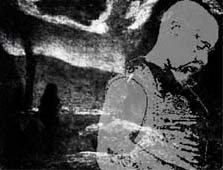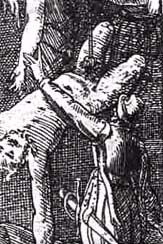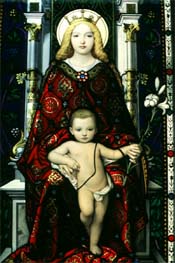 |


|
|
|
|
By Arthur Evans Author, Witchcraft and the Gay Counterculture and Critique of Patriarchal Reason
Gender is what you make of your sexual equipment. Suppose you have a cock and balls. That's the equipment. Pretty straightforward. What you do with the equipment is more complicated. It can range from the sublime to the horrendous. A common example: Suppose you're insecure about your masculinity. You pump up your muscles at a gym, get a buzz cut, and practice tough-guy poses. Why all the effort? Simple. You want to create a persona that will please the butch guys. You hope to find one (or more) who will fuck you. That's gender. One kind, anyway. Likewise with spirituality. It's what you make of your spiritual equipment. You have a spirit. That's the equipment. Your spirit is all the mental resources you draw on when you give meaning to your life. Pretty straightforward. What you do with the equipment is more complicated. It, too, can range from the sublime to the horrendous. A common example: Suppose you rebuke yourself for feeling attracted to a member of the same sex, confess these longings to an ecclesiastical bureaucrat, pray for forgiveness, and do penance. Why all the effort? Simple. You want to create a persona that will please the God of Love. Otherwise, he'll make you burn in Hell forever. That's spirituality. One kind, anyway. When gender and spirituality cross, sparks can fly. That happened in the Middle Ages and Renaissance. Many of the women and men burned at the stake as "heretics" and "witches" were actually victims of gender coercion, not just religious persecution. The authorities used religious ideology to impose gender conformity on people. Gender conformity, in turn, reinforced the institutional power of the authorities. This article gives some examples of the interplay of gender, spirituality, and institutional power. They're from a book I'm working on, Moon Lady Rising, which I hope to have out next year. It's an updated version of a book I wrote in 1978, Witchcraft and the Gay Counterculture, which is now out of print. Talking About Sex First a warning, though. I use the words "homosexuality," "gay," and "lesbian." Many contemporary academics say you can't do that when talking about the past. The word "homosexuality," they say, wasn't invented until the 19th century. Following French philosopher Michel Foucault, they say sexuality is "socially constructed." Different societies have different kinds of sexuality. You can't use words from one society to describe sexuality in another. But there's a problem here. The phrase "socially constructed" is ambiguous. It can mean either "socially influenced" or "socially determined." Foucault and his admirers often slide back and forth between these two meanings without being aware of it. Sexuality = gender + sexual equipment. So sexuality is indeed "socially influenced." That's because of the role of gender, which is a social creation. But sexuality is not "socially determined." To say so overlooks the role of the physical equipment (cocks, balls, cunts, hormones, genetic wiring, ejaculation, menstruation, pregnancy, birthing, lactation, menopause, etc.). Like everything human, our sexuality involves both culture and nature. Ignore either half, and you trivialize the human experience. The upshot: cultures differ in their treatment of sexuality, as Foucault and company rightly insist. Nonetheless, some people in every culture are primarily attracted to those who have the same kind of sexual equipment, some to those having different equipment, and some to both. For the first group, I use the words "gay," "lesbian," and "homosexual."
It's true the word "homosexual" didn't exist in ancient Greece and Rome. But no English words existed in ancient Greece and Rome. Does that mean we can't use English words to write about those times? Of course not. Buggers
In the 11th century, a counterculture began to develop in Western Europe. It was influenced by the revival of trade with the Balkans, especially Bulgaria. Ideas as well as goods traveled along the revived trade routes. Old pagan embers that had long warmed peripheral thinkers in the Balkans were now carried westward. There they sparked conceptual conflagrations. In France, Italy, and elsewhere, these Balkan sparks helped create an alternative form of Christianity known as Catharism. It differed sharply from institutional Christianity (the pope and his followers) in regard to gender and spirituality, and especially when it came to homosexuality. Institutional Christians denounced Catharism as a heresy and eventually destroyed it, in the 13th century. The Cathars, however, viewed themselves as the true Christians and called the institutional Christians heretics. An early example of Catharism comes from Bucy-le-long, France, near Soissons. The French abbot Guibert of Nogent mentions that two heretic brothers in the early 11th century had a following among the peasants. Guibert says the heretics denied that Christ suffered in the flesh, and rejected any sexual intercourse that led to birth. Instead, they practiced homosexuality: "You may see them living with women but not under the name of husband and wife ... but men are known to be with men, women with women." (Lambert, 49; Runciman, 120; Russell [1972], 94-95; Wakefield & Evans, 103)
Homosexuality and Cathar heresy became so interchangeable that those accused of heresy attempted to prove their doctrinal orthodoxy by proclaiming their heterosexuality. A 13th-century weaver accused of heresy replied: "Gentlemen, listen to me! I am not a heretic, for I have a wife and I sleep with her. I have sons." (Wakefield & Evans, 213) Mere suspicion of homosexuality was enough to condemn a person for heresy, even though the person was not known to have believed in any heretical doctrine. In 1381 an epileptic German beggar named Brother Hans was thought to have magical powers. He was arrested and tortured into confessing that he was a "perverter of young boys." He was consequently burned at the stake for heresy, even though no doctrinal dispute was involved. (Lerner, 145) Cathar leaders were not early gay activists. They preferred homosexuality over procreative sex because of complicated theological reasons. In fact, Cathar leaders themselves (Cathari - "the Purified Ones") were other-worldly to the extreme. But there was a big loophole. In Cathar theology, you could lead a worldly life until you received the sacrament of "consolation" (consolamentum). After that, you had to be completely ascetic. Most people put off receiving the sacrament until they were on their death beds. If you died before that, you wouldn't go to Hell. You'd just be reincarnated, and start the process over again. Eventually, everybody would get it right. Like the movie Groundhog Day. Catharism stressed lived experience rather than dogma as the defining mark of religion. The important thing was how you behaved toward other people, not whether you conformed to an official creed. The practical result of these beliefs was to turn Cathar-controlled areas in Europe into havens for gays and lesbians, as well as Jews, artists, and independent thinkers. Like San Francisco in the 1970s. Institutional Christians were outraged at this diversity in gender and spirituality, which they regarded as a grave offense to the God of Love. So they launched a holy war against Cathar areas and created the Holy Inquisition. The process took decades, but eventually Catharism was annihilated. In the end, institutional Christianity's rigid attitudes about gender and spirituality prevailed. Later they were perpetuated by Protestant divines, who transmitted them to secular thinkers in the Age of Reform. They continue to influence Western thought to the present day. Magical Christianity Catharism spread so easily because the peasants of the time still had a pagan sensibility. Most were illiterate, and so couldn't read the Bible, which was written in Latin (translated from Greek, Hebrew, and Aramaic). Priests were often poorly educated. Attendance at mass was sporadic. The emergent institutions of state, church, and university had only a tenuous hold on the countryside, where the overwhelming majority of people lived. Although calling themselves Christians, the peasants had beliefs and rituals that were saturated with ancient pagan motifs. Their brand of religion was a hybrid of rural paganism and Christianity, which I call magical Christianity. It stood in contrast to institutional Christianity -- the religion of popes, bishops, priests, monks, and academics (all men).
An example of magical Christianity comes from 14th-century Italy. On April 30, 1384, two peasant women of Lombardy, one known simply as Sibillia, the other as Pierina de' Bugatis, were summoned before the Inquisition, then sitting at a local church in Milan. The women confessed, apparently without torture, to things that scandalized the inquisitors. Sibillia claimed that every Thursday night she traveled with a certain Signora Oriente and "her society," giving her homage. Sibillia said Signora Oriente predicted the future and revealed secret things, a knowledge that Sibillia passed on to other people. Sibillia said she had never confessed these things before because she didn't believe they were sinful. (Bonomo, 15-17; Centini, 112-13, 235; Cohn [1975], 217-218; Kieckhefer, 21-22; Russell [1972], 210-19; Verga, 156 ff.) Pierina de' Bugatis said that both the living and the dead participated in these rites. Pierina said the celebrants traveled to the houses of the rich, where they ate and drank. When they found the houses well ordered, they blessed them. Signora Oriente taught the women the power of herbs, answered their inquires about diseases, told them where to find stolen things, and instructed them on how to remove curses. Pierina added that she "believes Oriente is mistress of her 'society' as Christ is master of the world." Under pressure from the Inquisition, Sibillia and Pierina abjured these practices. The inquisitor (Beltramino da Cernuscullo) imposed a light sentence. The women had to wear red crosses sewn onto their garments as penance, and on certain days stand in the doorways of churches during mass and the homily. Six years later, in 1390, Sibillia and Pierina were again hauled before the Inquisition of Milan for the same practices. But the inquisitor's interest had changed. He was no longer preoccupied with Signora Oriente. Now what he wanted to hear about was "the Devil." Did the women make a pact with him at these rites? Did they have sex with him? Prodded repeatedly, probably tortured, Pierina finally confessed that she had done so, having made a pact with the Devil in her own blood. Because this was their second offense, the two women were now relapsed heretics in the eyes of the church. Cernuscullo turned them over to the secular authority, which executed them. Moon Lady Rising Many Anglo-American historians have made light of Sibillia and Pierina, calling them "silly old women." (Cohn, 217) These sexist and ageist biases have led them to overlook an important linguistic clue. The scoffing historians have failed to realize that the name "Signora Oriente" is the Italian equivalent of the Latin "Domina Oriens." This Latin name literally means "The Lady Who Rises in the East." Precedents in classical Latin literature show that this name refers to the moon. (Lewis & Short, orior) The Italian women were not anomalies. They worshipped the moon, calling her by the name of Signora Oriente. Going into trances, they had visions of following in her train as she traversed the night sky, accompanied by the souls of the dead. Through these experiences, the women hoped to learn how to heal people, predict the future, and counter evil charms. At the same time, they regarded themselves as good Christians. In the eyes of the Inquisition, they were worshipping the Devil. Thanks largely to the work of Italian scholars, we now know that many European peasants had visions similar to the experiences of these two women. Reports of such visions span a wide range of both geography and time. The moon goddess had many different names in addition to Signora Oriente, including the Latin Diana and the German Holda. Although varied, these practices shared a number of common features. Participants loved and worshipped the forces of nature. They acknowledged a prominent religious role for women. They regarded sex as a divine force. They worshipped more than one god. And they viewed themselves as good Christians. Hail Mary
Although medieval priests used Mary to lecture women about chastity and to call everyone to penance, they couldn't smother the rural magic she had picked up. Early medieval peasants saw Mary and Signora Oriente as cut from the same cloth, as in fact they were. The association between the two weakened after the conflict with the Cathars. From then on, the Roman hierarchy worked diligently to repress the magical, feminine, and anarchic elements that had helped create magical Christianity. A big part of the endeavor was to make Mary more serviceable to institutional dogma. With the Counter-Reformation of the 16th century, the clergy got complete control of Marian chemistry. Whatever experience the faithful might have of Mary, priests precipitated from it a single message: do penance, and submit to the authority of the church. Otherwise, the vision was discounted. Today some of the Catholic faithful still have experiences of Mary that don't fit into the institutional mold. But as filtered and proclaimed by the modern hierarchy, Mary has lost most of her connections to the old goddesses and become a mere mouthpiece for papal bulls. An example is provided by the famous "three secrets of Fatima," delivered by Mary at Fatima, Portugal, in 1917. According to the Vatican, the three secrets are about penance, international politics, and the well-being of the pope. (Message of Fatima) The secrets have nothing to do with the practical, day-to-day needs of women and peasants. The official Mary of today's Roman Catholic hierarchy is nothing more than the pope in drag. Self-Determination Organized religion is not the same as spirituality. Organized religion = spirituality + hierarchy + property. The above examples show how organized religion in the past has used spirituality as a cover for imposing gender definitions on people. People must not have sex with members of the same sex. Women must not have a leadership role in religion. The process continues. A big part of the agenda of the religious right in America today is to attack self-determination in gender. Invoking the name of God, the religious right demonizes women who assert control over their own bodies, people who have sex with members of the same sex, and transgender people. The posture is spiritual, but the goal is political: the regimentation of gender. We don't have to settle for anybody else's definition of our gender or spirituality, whether by religious institutions, peer groups, the mass media, fantasy merchants, or gurus. We can create our own gender and spirituality. All that's required is to cultivate values from authentic living and to live them in body and spirit. It's called being a person. Citations: Bailey, Derrick, Homosexuality and the Western Christian Tradition, Archon Books, 1955; reprinted 1975 Berger, Pamela, The Goddess Obscured: Transformation of the Grain Protectress from Goddess to Saint, Beacon Press, Boston, 1985 Bonomo, Giuseppe, Caccia alle streghe: la credenza nelle streghe dal secolo XIII al XIX con particolare riferimento all'Italia, Palumbo, Palermo, 1959 Centini, Massimo, Le schiave di Diana: stregoneria e sciamanismo tra superstizione e demonizzazione, Edizione Culturali Internazionali Genova, Genoa, 1994 Cohn, Norman, Europe's Inner Demons, Sussex University Press, London, 1975 Grimm, Jacob, Deutsche Mythologie, 4th edition, vol. I, Wissentschaftliche Buchgesellschaft, Berlin, 1875 Hughes, Pennethorne, Witchcraft, Penguin, Baltimore, 1965 Kieckhefer, Richard, European Witch Trials, University of California Press, Berkeley, 1976 Lambert, Malcolm, Medieval Heresy: Popular Movements from the Gregorian Reform to the Reformation, 2nd ed., Blackwell, Oxford, 1992 Legman, G., The Guilt of the Templars, Basic Books, New York, 1966 Lerner, Robert, The Heresy of the Free Spirit in the Later Middle Ages, University of California Press, Berkeley, 1972 Le Roy Ladurie, Emmanuel, Montaillou: The Promised Land of Error, trans. by Barbara Bray, Vintage Books, 1979 Lewis, Chartlon, and Charles Short, A Latin Dictionary, The Clarendon Press, Oxford, 1966 Loos, Milan, Dualist Heresy in the Middle Ages, Martinus Nijhoff, The Hague, 1974 Markale, Jean, Women of the Celts, Gordon Cremonesi, 1975 Message of Fatima, The, Congregation for the Doctrine of the Faith, Vatican City, June 2000 Runciman, Steven, The Medieval Manichee, Cambridge University Press, 1947 Russell, Jeffrey, Witchcraft in the Middle Ages, Cornell University Press, Ithaca, NY, 1972 Taylor, G. Rattray, Sex in History, Vanguard Press, New York, 1954 Verga, Ettore, "Intorno a due inediti documenti di stregheria milanese del secolo XIV," in Rendiconti del Reale Istituto Lombardo di Scienze e Lettere, ser. II, 32, 1890, 156 ff. Wakefield, W.L., and A.P. Evans, Heresies of the High Middle Ages, Columbia University Press, New York, 1969 Warner, Marina, Alone of All her Sex: the Myth and Cult of the Virgin Mary, New York, 1976 Wright, Thomas, "The Worship of the Generative Powers During the Middle Ages of Western Europe," in Sexual Symbolism: A History of Phallic Worship, The Julian Press, New York, first published in 1866, reprinted 1957 |

© 1997-2002 BEI
 "Gender" and "spirituality" are two buzz words that fly around a lot today. But what is gender? What is spirituality? And what happens when they mix?
"Gender" and "spirituality" are two buzz words that fly around a lot today. But what is gender? What is spirituality? And what happens when they mix?
 A male victim being tortured during the Inquisition
A male victim being tortured during the Inquisition  Women accused of being witches in Salem, Massachusetts
Women accused of being witches in Salem, Massachusetts  The Virgin Mary: Used by the Catholic Church to stifle magical Christianity in the Middle Ages
The Virgin Mary: Used by the Catholic Church to stifle magical Christianity in the Middle Ages